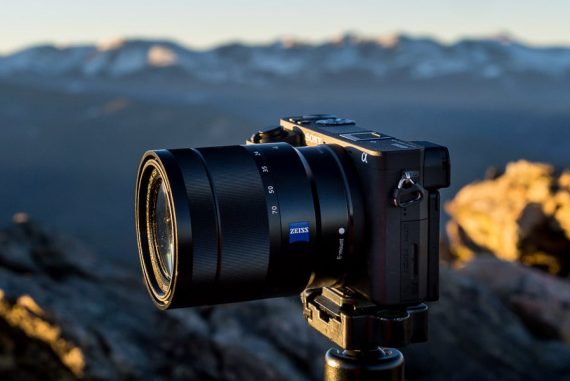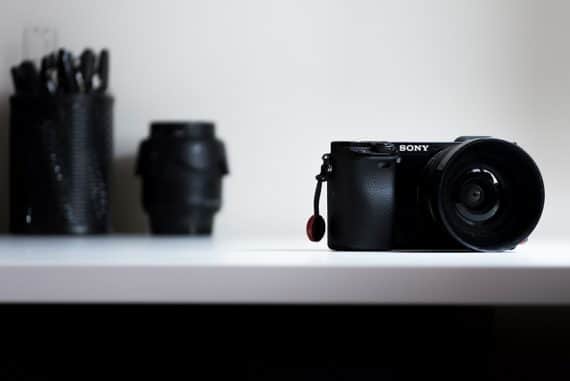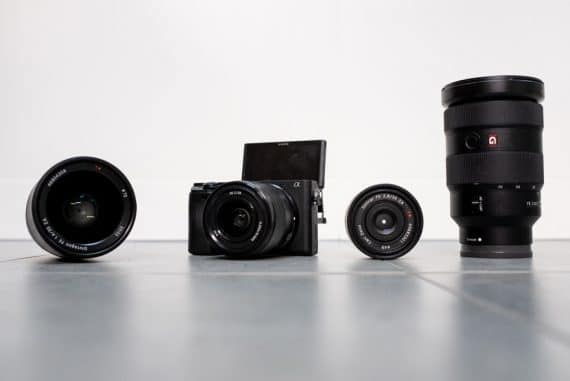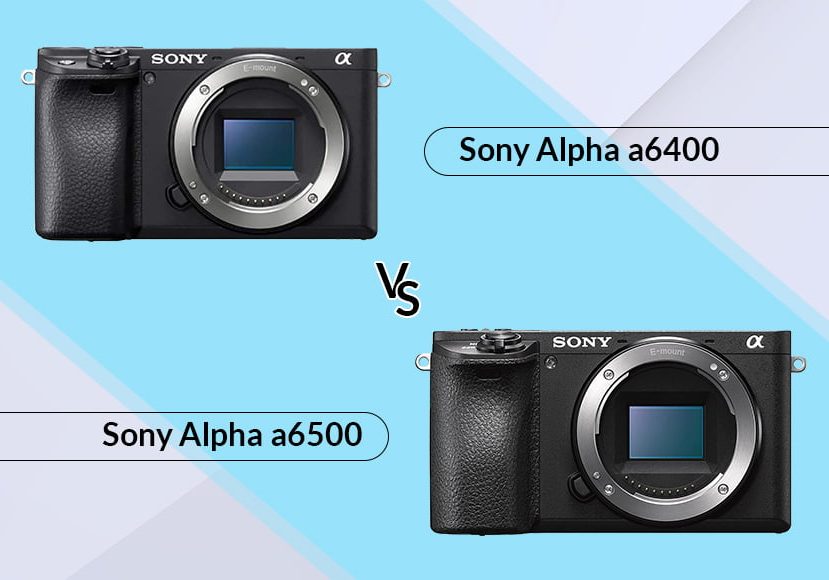
Sony a6400 vs a6500 Compact Camera Comparison
Which camera wins between the Sony a6400 vs a6500? Find out the pros and cons of each and which is best for you in this detailed guide!
If you’re struggling to determine the perfect camera for your needs, this Sony a6400 vs a6500 guide could be exactly what you need.
In it, you’re going to discover everything you need to know about these two cameras.
How they compare. What they offer. And whether the Sony a6400 or the Sony a6500 is right for you.
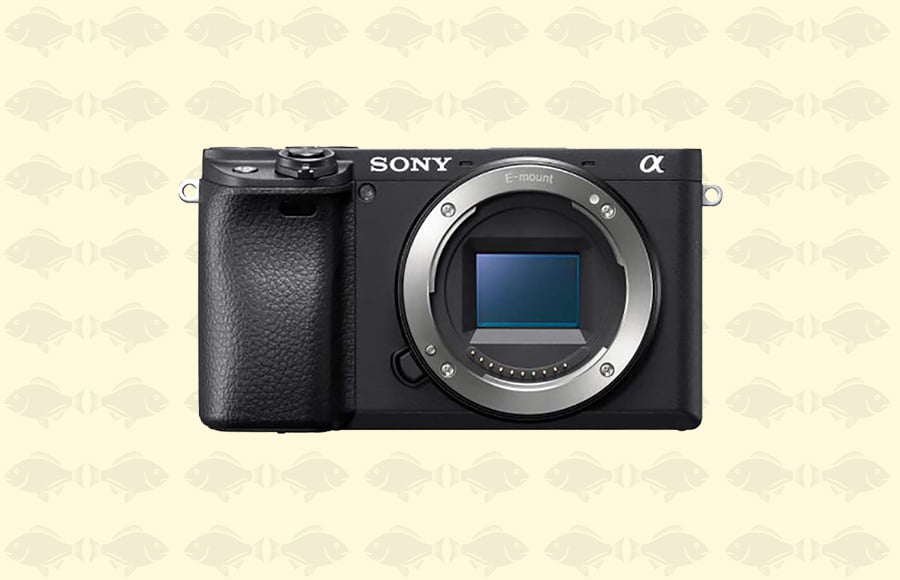
Superior video capabilities, lightening fast autofocus and exceptional AF tracking put the a6400 out in front.
Both of these cameras pack some incredible features and give you access to the wide range of Sony e-mount lenses.
And while neither the a6400 nor the a6500 are the latest of Sony’s APS-C mirrorless models, both will help you take some great photos.
Are you ready to select your next camera?
Let’s get started with the full comparison.
Sony a6500 vs a6400 | Key Differences
1. Size & Weight
If you’re looking for the lightest camera you can get your hands on, then the Sony a6400 is the better choice.
It weighs just 403 grams (14.22 ounces), edging out the a6500 (at 453 grams/15.98 ounces). While the difference may not seem like much, even small amounts of weight can be an issue when travelling for long periods.
Note that neither camera is particularly light when compared to other APS-C mirrorless models, though they are among Sony’s lightest options that include an electronic viewfinder.
As for size:
While the two cameras are nearly identical, the Sony Alpha a6500 (120 x 67 x 53 mm) is slightly more compact than the a6400 (120 x 67 x 60 mm), sporting a thinner design overall.
Is the size difference enough to be useful?
That depends on your needs. But a few millimeters can be a lifesaver, especially if it allows you to neatly fit your camera body into a suitcase, a backpack, or even a pocket.
Street photographers will appreciate the slightly thinner design, as well – because the thinner the camera, the more discreet it becomes. In this Sony Alpha 6400 vs Sony Alpha 6500 specs battle, it’s a draw.
2. Ergonomics/Handling
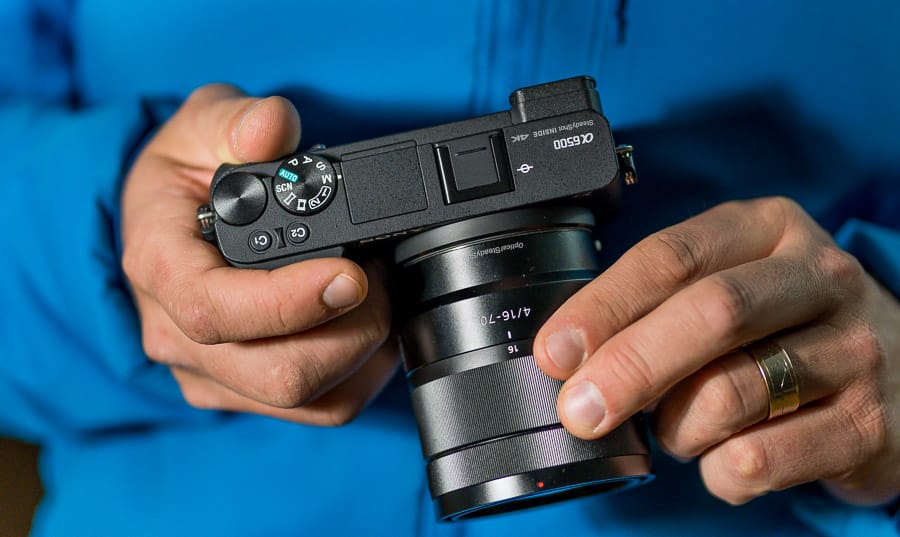
Sony Alpha a6500 | Credit: Marc Bergreen
In terms of ergonomics, The Sony a6400 vs 6500 are nearly identical. Both bodies are going to feel very compact, especially if you’re used to using a DSLR, and I wouldn’t go so far as to say that either one is comfortable.
But Sony’s design is decent, even if things do feel a bit cramped compared to bigger mirrorless cameras and pretty much any DSLR.
Note that both models include Sony’s less-than-optimal menu system, though the a6400 has the newer, slightly improved version.
Now, the buttons and dials are almost unchanged from the Sony a6500 to the Sony a6400. But the a6500 does feature an extra custom button, which may come in handy for changing settings on the fly.
On the other hand, the Sony a6500 offers a more prominent grip; this makes it a bit easier to hold for long periods of time.
Unless you’ve used a Sony Alpha a6000-type body before, you’ll probably get the sense that these models have a few too many buttons and not enough camera.
But you’ll get used to it pretty quickly, and you’ll come to appreciate the benefits that a compact camera like the a6400 or a6500 can bring.
3. Rear LCD & EVF
On the surface, the rear LCDs of the a6400 and a6500 are near indistinguishable. They feature a viewfinder resolution of 922k dots as well as touch screen functionality, which is useful on cameras where you’ll be shooting using Live View for a lot of the time.
The LCD screen on the Sony a6400 flips up a full 180 degrees, while the a6500’s LCD screen merely tilts during Live View. Have a closer look in our Sony a6400 review.
A rotating screen is critical for vloggers and videographers who frequently find themselves in front of the camera. It can also be useful for architectural and macro photographers, who often find themselves shooting at odd angles.
Now, the Sony a6400 and a6500 offer the same electronic viewfinder: OLED, 2.36m-dots.
And while the resolution on these EVFs is hardly class-leading, they’re both good for casual use and should be enough to satisfy most photographers, especially those who use Live View over the EVF.
Overall, though, we prefer the flip-up screen of the Sony a6400, which allows for better vlogging and selfies. One caveat – the screen can get blocked if you use an external microphone in the hot-shoe of the camera. The solution is to use a mini rig, allowing you to mount the mic to the side of the screen.
4. Image Quality

Sony Alpha a6400 APS-C image sensor | Credit: Daniel Stark
The Sony a6400 and a6500 are both fairly strong performers when it comes to image quality. They’re not top-of-the-line good, but for APS-C cameras, they do a good job of combining resolution and low-light capabilities.
Both feature an identical APS-C 24-megapixel CMOS sensor. And while neither is a standout low-light performer, you do get a lot of bang for your buck.
Note that while the APS-C sensors are the same, the a6400 includes an upgraded processor. In practical terms, this means you can push your ISO range to 32000 (over the a6500’s 25600 maximum), and you can use the camera’s expanded ISO range settings to reach ISO 102800 (compared to ISO 51200 in the Sony a6500).
Does this translate to better high-ISO shooting in the a6400?
While high ISO range performance may be marginally improved, it’s probably not something you’ll notice without a careful head-to-head comparison. Image quality is virtually the same on these two APS-C CMOS sensor mirrorless cameras.
(You can see more samples of the image quality of the Sony a6500 in this review.)
5. Autofocus
If there’s one area where the Sony a6400 blows the a6500 out of the water, it’s autofocus.
The Sony a6400 was the first Sony camera to include Real Time Tracking, which is quite possibly the best autofocus implementation in a mirrorless camera, period.
The Sony a6400 will follow subjects will amazing accuracy and speed, switching from face-detection to eye AF to object tracking as your subject moves. It’s perfect for anyone shooting wildlife, sports, or any other action-focused genre.
Real Time Tracking is truly a wonder to behold, and while the Sony a6500 is no slouch in the autofocus department, it can’t hold a candle to the a6400’s capabilities.
Both mirrorless cameras also offer Eye AF, which allows you to nail focus on your subject’s eyes in an instant. Eye AF is a huge bonus for portrait photographers and street photographers, where grabbing focus on the eyes is critical.
But once again, the a6400 is the better option: It features Sony’s new Real Time Eye AF, which requires no dedicated Eye AF button and is far easier to use when out shooting.
You also get an increased number of contrast detection points on the a6400 (425 points on the a6400 and 169 on the a6500). The increased number of contrast detection points makes for great AF coverage overall, allowing the a6400’s AF system to span the entire sensor.
However, the two cameras include identical phase detection point counts (425), which helps for accurate AF performance.
6. In-Body Image Stabilization
If there’s one key area where the Sony a6500 comes out on top, it’s this one: 5-axis in-body optical image stabilization. This is yet another key difference between Sony a6400 and a6500.
The a6500 has sensor-shift image stabilization, but the a6400 doesn’t have anything.
Now, the IBIS capabilities on the Sony a6500 aren’t especially impressive. While you can combine optically stabilized Sony e-mount lenses with the a6500’s in-body stabilization, you don’t get much of a stabilization boost.
But if you’re a videographer, or a low-light shooter who often works with still subjects, image stabilization can be a make-or-break feature.
You’ll be able to shoot handheld video without worrying as much about camera shake – plus, the presence of in-body image stabilization will give your video recording a smoother, professional feel.
7. Drive (FPS)
The Sony a6400 and Sony Alpha a6500 both offer impressive continuous shooting capabilities, making either one of these bodies work as an excellent compact action camera.
You get 11 frames per second continuous shooting, which outclasses almost every DSLR on the market (even if it pales in comparison to mirrorless models offered by Fujifilm and Olympus).
When it comes to buffer, however, the a6500 does perform better than the a6400, clearing the memory card faster.
The Sony a6500 can shoot 107 RAW images (or 233 JPEGs) without pause, compared to 46 RAW images (or 99 JPEGs) on the a6400.
This shouldn’t matter much if you’re a casual shooter – but if you’re a sports or wildlife photographer, this is a major point in favor of the a6500.
When you’re photographing a once-in-a-lifetime moment, a deep buffer can be the difference between an award-winning shot and complete failure.
Both cameras have a fast maximum shutter speed of 1/4000s with the mechanical shutter. However, only the Sony a6500 offers an electronic shutter speed of 1/32000.
8. Battery Life
Sony’s APS-C mirrorless cameras consistently underwhelm when it comes to battery life, and neither of these cameras manages to break that trend.
The CIPA rating for the Sony a6500 is 310 shots, versus 360 shots on the a6400.
Now, fifty shots can make a difference. If you’re shooting in bad weather, for instance, not having to change your battery is a big deal.
But either way, you’re going to want at least one extra battery – and maybe two or three, depending on how long you stay out shooting and how hard you push your cameras.
9. Video
The core video capabilities on the Sony a6500 vs a6400 are the same:
Both cameras include 4k/30p video recording, and both cameras use the full sensor width to do it. You also get full HD recording at 120 fps, which is great for slow motion footage.
4K video at 30p isn’t the absolute best video quality on the market, but it’s far from bad, and should be enough to satisfy most hobbyist videographers.
Unfortunately, neither camera includes a headphone jack. But the a6400 does drop the 30-minute video limit present on the a6500, a bonus for anyone interested in capturing long video clips.
10. Price
As of right now, the Sony a6400 is slightly cheaper than the Sony a6500.
Both are solidly in the sub-1000 USD range when purchased body-only, and if you buy used you can get them for substantially cheaper.
Bottom line:
These are two great deals for two great cameras.
But the a6400’s lower price is tempting, especially when you consider the upgraded autofocus performance and 180-degree tilting LCD screen.
Frequently Asked Questions
Is Sony a6400 better than Sony a6500?
It depends on your needs. The a6400 offers much-improved autofocus, as well as a 180-degree tilting touchscreen. But the Sony a6500 has a better buffer and in-body image stabilization.
Is the Sony a6400 weather sealed?
Yes. Both the Sony a6400 and the Sony a6500 are weather sealed.
Does the Sony a6400 have image stabilization?
No. Out of Sony’s a6000 lineup, only the Sony a6500 and a6600 have image stabilization (though Sony does offer a number of Sony e-mount stabilized lenses that will work on the a6400).
Sony a6400 vs a6500 | Final Comparison

Sony a6400 | Credit: Mark Condon
Both the APS-C sensor Sony Alpha a6500 and a6400 offer a lot to be excited about – especially if you’re a compact camera shooter looking to upgrade to your first interchangeable lens camera, or you’re a hobbyist DSLR shooter looking for something more compact.
The Sony a6500 is a few years older than the a6400, but it’s held up surprisingly well. It even manages to outcompete the a6400 in a few key areas, including buffer depth and in-body image stabilization.
But there are areas where the Sony a6500 shows its age. I’m talking about things like the new autofocus system on the a6400, which has been making waves ever since its announcement and has taken AF tracking to the next level.
Plus, the Sony a6400 includes the 180-degree tiltable screen, a real benefit for vloggers, and the reason it’s been described as a ‘vlogger’s camera.’ (You can also compare it to the a6100 in this respect.)
In the end, the decision is up to you, and it’ll come down to your specific needs from your camera as a photographer.
Are you looking for insanely fast autofocus speeds and some of the best AF tracking available on any camera, all for an impressively low price?
Then go for the Sony a6400.
But if you want some extra image stabilization, or you’re in need of a deep buffer, then the Sony a6500 may be the better choice.

Superior video capabilities, lightening fast autofocus and exceptional AF tracking put the a6400 out in front.





